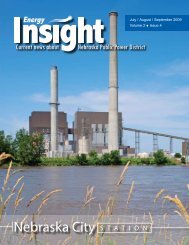January / February 2009 - Nebraska Public Power District
January / February 2009 - Nebraska Public Power District
January / February 2009 - Nebraska Public Power District
Create successful ePaper yourself
Turn your PDF publications into a flip-book with our unique Google optimized e-Paper software.
12 ENERGY INSIGHT • jaNuaRY / fEbRuaRY <strong>2009</strong><br />
ENERGY INSIGHT • jaNuaRY / fEbRuaRY <strong>2009</strong> 13<br />
Water discharge project to begin in february<br />
The most visible portion of NPPD’s Sheldon<br />
Station Water Discharge Project is scheduled<br />
to begin in <strong>February</strong>, according to Scott Estvold,<br />
project manager. The 10-mile long water discharge<br />
line construction is expected to be<br />
complete in July, with the entire<br />
project slated to be finished in 2010.<br />
The pipeline is just one<br />
portion of the project, on-site<br />
modifications is another. On-site<br />
modifications involve the plant’s<br />
drain piping systems and developing<br />
pond treatment facilities that<br />
will condition the water before<br />
discharging through the new pipeline<br />
from Sheldon Station into the Big<br />
Blue River.<br />
This project was necessitated<br />
when the <strong>Nebraska</strong> Department<br />
of Environmental Quality issued NPPD a revised<br />
water discharge permit that included more stringent<br />
standards than previously required. In order to<br />
meet the new permit requirements, modifications to<br />
Sheldon Station’s entire water treatment and discharge<br />
system must be made. The new system will provide<br />
control of water discharge from the facility, according<br />
to Joe Citta, NPPD environmental manager.<br />
NEW PERMIT<br />
REQuIRES<br />
MODIfICaTIONS<br />
TO SHELDON<br />
STaTION’S<br />
ENTIRE WaTER<br />
TREaTMENT<br />
aND DISCHaRGE<br />
SYSTEM.<br />
“What will happen is that we will have a new<br />
system with lined ponds that will treat runoff water<br />
individually from coal piles and several plant<br />
processes before being discharged,” Citta explained.<br />
“Water that comes from the discharge<br />
pipeline to the Big Blue River will meet<br />
all discharge standards that have been<br />
established.” Design of the on-site process<br />
and the pipeline has been approved by the<br />
NDEQ and construction permits have been<br />
issued.<br />
Estvold explained that the schedule is<br />
subject to change based on weather or other<br />
uncontrollable factors. He also noted that<br />
two public events have been held regarding<br />
the project, one an informational meeting<br />
in March 2007 and the second was a formal<br />
public hearing on the line selection route,<br />
held in October 2007.<br />
Construction work on the pipeline will be handled<br />
by Kissick Construction Company of Kansas City,<br />
Mo.<br />
Sheldon Station is an important facility in NPPD’s<br />
energy supply fleet. Two units collectively generate<br />
225 megawatts of electricity, which is enough to meet<br />
the needs of nearly 105,500 residents each year. The<br />
facility has been in commercial operation since 1961.<br />
Gerald Gentleman Station sets generation records<br />
Records are made to be broken. And that is<br />
exactly what happened in 2008 for Gerald<br />
Gentleman Station.<br />
On Dec. 30, 2008, at approximately 11 p.m., the<br />
station broke its five-year old electric generation<br />
record and completed the year<br />
generating a total of 9,830,577<br />
megawatt-hours. This mark<br />
exceeded the previous record of<br />
9,782,517 MWh recorded in 2003.<br />
Reasons for the increase in<br />
generation include electrical<br />
load growth and customer usage<br />
during one of the coldest winters<br />
in recent years. The result is a<br />
generation record for the station<br />
itself, as well as the highest annual<br />
generation record for all NPPD<br />
facilities in the state.<br />
GGS is one of three<br />
“baseload” generation facilities NPPD relies<br />
upon to provide power for its retail and wholesale<br />
customers throughout <strong>Nebraska</strong>. The station serves<br />
approximately half of NPPD’s customer base and is<br />
the utility’s largest generating facility.<br />
IN DECEMbER, GGS<br />
SuRPaSSED ITS fIVE-<br />
YEaR OLD ELECTRIC<br />
GENERaTION<br />
RECORD. THE<br />
STaTION GENERaTED<br />
9,830,577 MEGaWaTT-<br />
HOuRS IN 2008.<br />
“The station personnel have a done a great job<br />
over the years, in operating the units conservatively<br />
and keeping the facility well maintained; this put us<br />
in a good position to set a new generation mark,” said<br />
Mick Spencer, GGS manager. “While our goal is to<br />
keep the GGS units performing<br />
well in the long term, the record is<br />
a nice bonus, and it speaks to the<br />
importance of maintaining the value<br />
of a key asset to NPPD’s generation<br />
system.”<br />
GGS has two operating<br />
units, each is able to generate<br />
approximately 650 megawatts of<br />
electricity. Unit 2 exceeded its<br />
previous generation record for the<br />
year recording 5,399,171 MWh in<br />
2008, topping the previous best of<br />
5,062,981 MWh recorded in 2006.<br />
Located near Sutherland, GGS<br />
has consistently been recognized as one of the lowest<br />
cost, coal-fired generating stations in the nation. Unit 1<br />
began operation in 1979 and Unit 2 in 1982.









